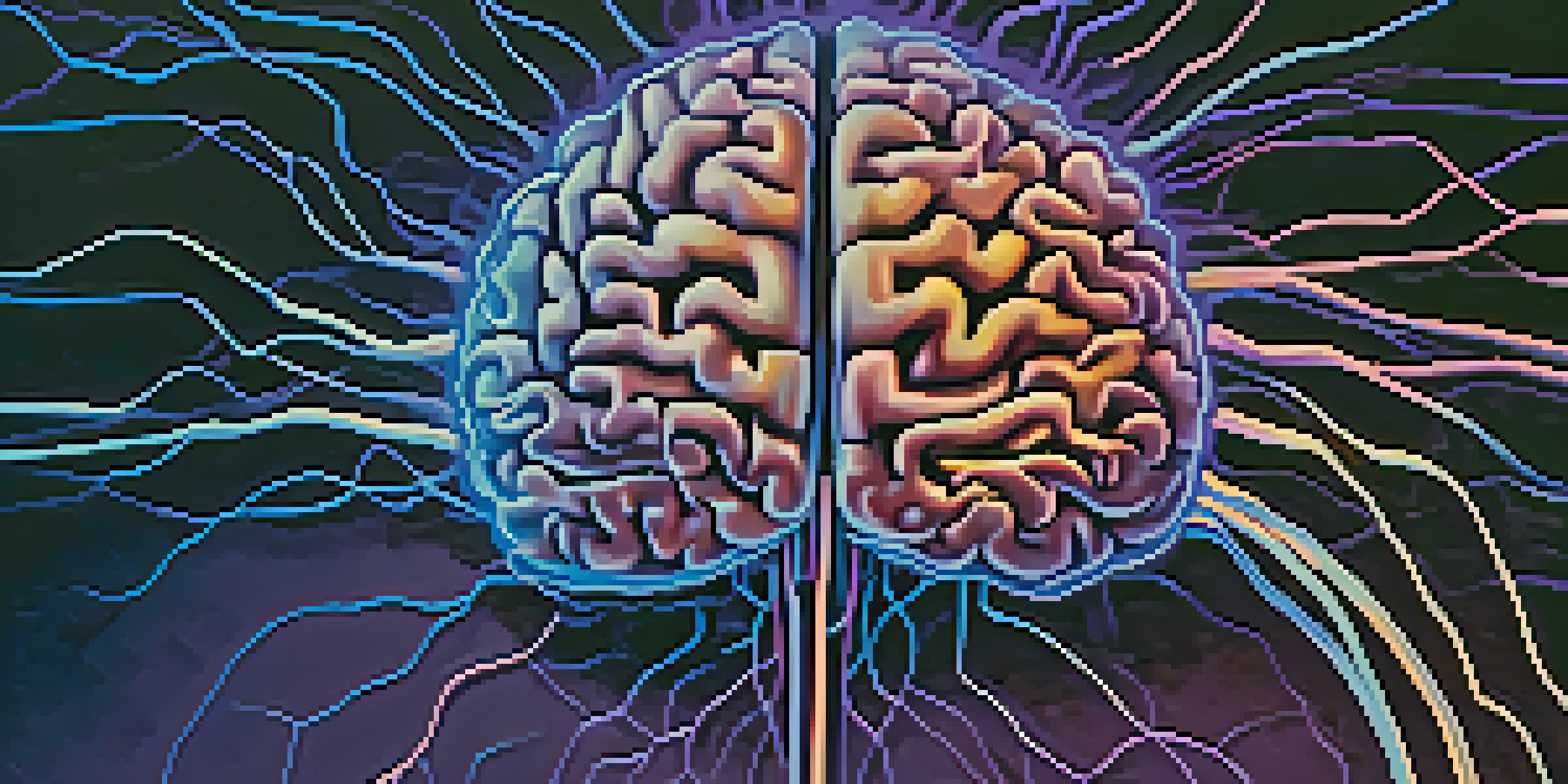The Role of Glutamate in Hallucinogenic Experiences Explained

What is Glutamate and Its Role in the Brain?
Glutamate is a critical neurotransmitter in the brain, acting as the primary excitatory signal. It plays a vital role in synaptic plasticity, which is essential for learning and memory. Think of glutamate as a friendly messenger that helps neurons communicate effectively, ensuring our brains function smoothly.
The brain is a complex organ, and its chemistry is a fine balance that affects our perception and consciousness.
Without glutamate, our cognitive functions would suffer significantly, leading to various neurological issues. This neurotransmitter is involved in many brain functions, including perception, emotion, and coordination. Essentially, it’s the glue that holds our brain’s communication network together.
Understanding glutamate is crucial, especially when exploring its role in hallucinogenic experiences. These experiences often involve altered perceptions and heightened emotional states, which can be linked to the complex interactions of glutamate within the brain.
Hallucinogens: A Brief Overview
Hallucinogens are substances that induce alterations in perception, mood, and cognitive processes. Common examples include LSD, psilocybin (found in magic mushrooms), and DMT. These substances can create vivid sensory experiences that feel remarkably real, even though they are not based in reality.

While the effects of hallucinogens can vary widely among users, they often lead to profound changes in consciousness. Many people report feelings of interconnectedness, spirituality, or even experiences of ego dissolution. This transformative nature is what draws many to explore these substances.
Glutamate's Key Role in the Brain
As the primary excitatory neurotransmitter, glutamate is essential for communication between neurons, impacting learning, memory, and overall cognitive function.
To understand how glutamate fits into this picture, we must consider how hallucinogens affect neurotransmission. By interacting with specific receptors in the brain, these substances can significantly alter how glutamate functions, leading to the unique experiences associated with hallucinogens.
How Glutamate Influences Hallucinogenic Effects
When hallucinogens are consumed, they often interact with serotonin receptors, but they also influence glutamate transmission. This modulation can enhance synaptic communication and lead to increased sensory perception. Imagine turning up the volume on your favorite song; everything becomes more vivid and intense.
Psychedelics can induce profound shifts in consciousness, revealing the intricate dance of neurotransmitters like glutamate.
Research has shown that increased glutamate levels can lead to heightened synaptic activity, which is key in creating those altered states of consciousness. These changes can result in vivid visual and auditory hallucinations, as well as profound shifts in emotional states. It’s like opening a window to a different reality, where everything feels amplified.
Thus, the role of glutamate is crucial in shaping the hallucinogenic experience. Its ability to enhance neural communication contributes significantly to the sensations and perceptions that users may encounter during their journeys.
The Science Behind Glutamate and Hallucinations
Studies have indicated that glutamate activity is elevated during hallucinogenic experiences. This is particularly evident in brain imaging studies, where enhanced connectivity in certain brain regions is observed. These findings suggest that the brain is operating in overdrive, creating a cascade of vibrant experiences.
The relationship between glutamate and hallucinations can also be seen in conditions like schizophrenia, where glutamate dysregulation is a factor. In such cases, individuals may experience hallucinations similar to those induced by hallucinogenic substances. Understanding this connection can provide insights into both normal and altered states of consciousness.
Hallucinogens and Glutamate Interaction
Hallucinogens influence glutamate transmission, enhancing sensory perception and leading to transformative experiences.
Moreover, the interplay between glutamate and other neurotransmitters, like dopamine and serotonin, adds another layer of complexity. This intricate dance between chemicals can lead to the unique and often unpredictable effects of hallucinogens, making each experience distinct.
Psychological Implications of Glutamate Activity
The psychological effects of hallucinogens can be profound, often leading to lasting changes in perspective or emotional state. Increased glutamate activity may contribute to feelings of euphoria, awe, or even anxiety during these experiences. It’s akin to riding a rollercoaster; the ups and downs can leave a lasting impression.
For some users, these experiences can facilitate personal growth or enhance creativity. The heightened emotional states induced by glutamate can help individuals process past traumas or gain new insights into their lives. This therapeutic potential has sparked interest in using hallucinogens for mental health treatment.
However, it’s essential to approach these experiences with caution, as they can also lead to negative psychological effects. Understanding the role of glutamate can help users better navigate their experiences and integrate the insights gained into their daily lives.
Potential Risks Associated with Glutamate Dysregulation
While glutamate plays a crucial role in enhancing hallucinogenic experiences, dysregulation can lead to adverse effects. High levels of glutamate can result in neurotoxicity, potentially leading to brain damage or disorders. This highlights the fine balance that must be maintained within our brain’s chemistry.
Additionally, individuals with pre-existing mental health conditions may be more susceptible to negative effects from hallucinogens. Increased glutamate activity can exacerbate symptoms in those already dealing with anxiety, depression, or psychosis. It’s vital for such individuals to approach hallucinogens with caution and awareness.
Risks of Glutamate Dysregulation
While glutamate enhances experiences, its dysregulation can cause neurotoxicity and exacerbate mental health issues, highlighting the need for caution.
Understanding these risks can empower individuals to make informed decisions about their experiences. Knowledge of glutamate’s role in both enhancing and potentially harming can encourage responsible use and promote mental well-being.
Future Research Directions on Glutamate and Hallucinogens
The relationship between glutamate and hallucinogenic experiences is a burgeoning area of research, with many questions still unanswered. Future studies aim to explore the precise mechanisms by which glutamate influences perception and consciousness. This could lead to breakthroughs in understanding how our brains create reality.
Researchers are also examining the therapeutic potential of hallucinogens in treating mental health conditions. By gaining a deeper understanding of glutamate’s role, scientists hope to harness the benefits of these substances while minimizing risks. It’s an exciting time in the field of psychedelic research.

As we continue to unravel the complexities of glutamate and hallucinogens, we may discover new avenues for enhancing mental health and well-being. The journey into the brain’s chemistry is just beginning, and the possibilities are vast.